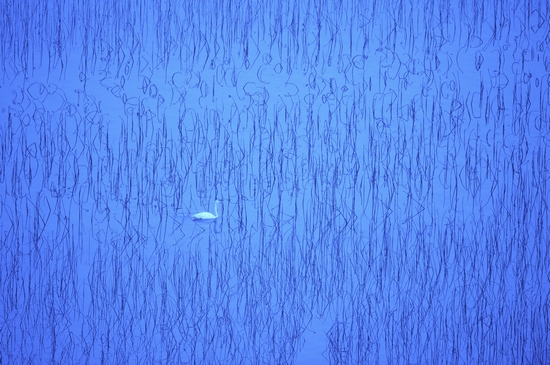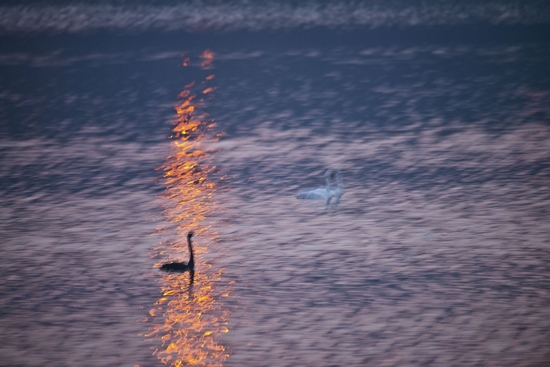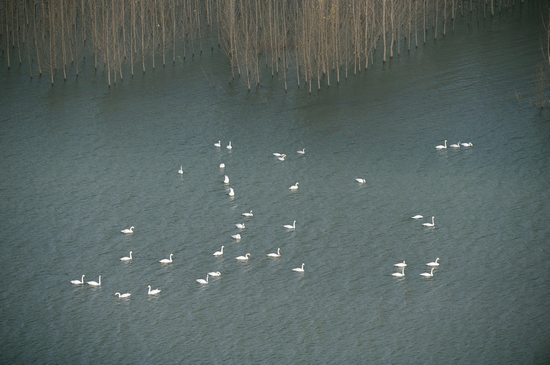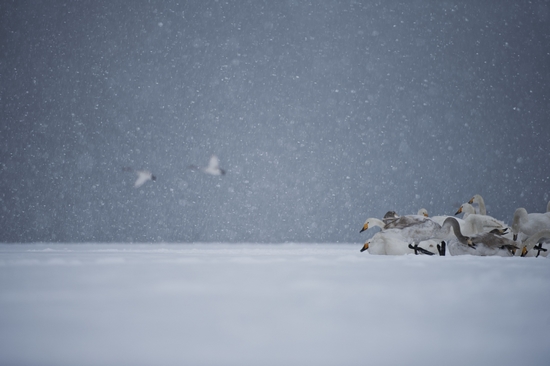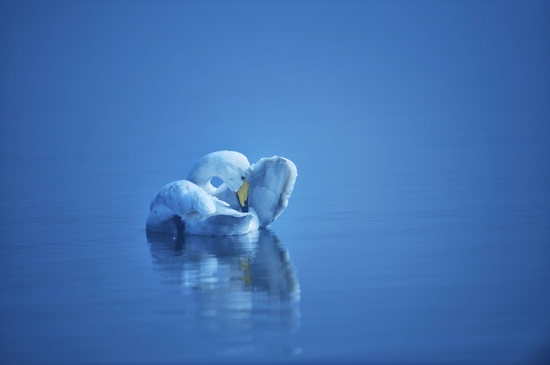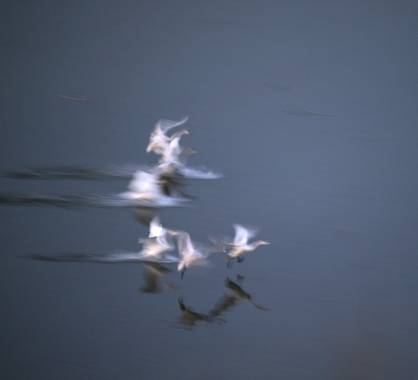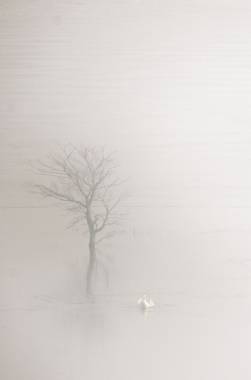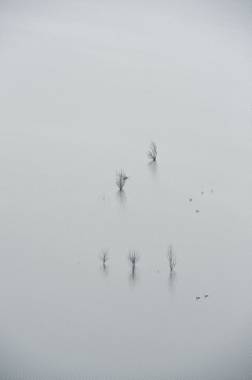Titled with Illusion in the Reality, Xu Daqing Photography Album published recently by China Photography Press is a collection of more than 70 pictures of swans taken in latest years. As every and each photo is not improvised shot for landscape at the first sight, this album embodies Xu Daqing’s painstaking efforts in artistry. Focusing on the light, shadow, scenery, object, image and position, his creation is a kind of expression of his attitude, pursuit, ideal and spirit in arts after thorough consideration. Swan is a migrant bird filled with spirits and human nature. During the migration between north and south every year, their solidarity, perseverance and their unique lineup of “1”or “Y”shape provide a profound enlightenment and inspiration for mankind and therefore become a favorite image in plenty of literature and video shots. In group dwelling, black or white, swans practice monogamy for a lifetime. Their giant body, elegant manners and long necks made them a symbol of loyalty, innocence, good will, refinement and nobility and invariable subject and theme in art creation. For example, the ballet Swan Lake, thanks to people’s favor of swan and respect for their spirits, is a classic masterpiece in almost everyone’s heart.
In a global photographic history, we can find countless excellent photos and masterpieces of swan by depicting their beautiful gesture and elegant manner in playing, walking, swimming and flying. Almost all the countries in the world adopted the photos of swan in issuing national stamps as classic impression of swan. In a word, we normally will find various photos of swan as much as we can expect and imagine in any art creation of swan. However, Xu Daqing’s presentation far transcends our habits, expectation and knowledge in aesthetics and brings to us surprise and amazing experience.
In this album, there will be swan in every photo, but more than 90% of the photos are narrations in a remote background or grand situation and the image of swan is not necessarily the main object in narration. What the author intends to convey is a kind of spectacle, situation, layout, image, scenery as well as the embodied objective, thoughts, concept and aesthetics. Though occupying limited, or we can say, little, tiny space, swan is the key element to bring the works to life echoing with the theme, like an apt word to clinch the point.
For example, the photos titled Butterfly Dance, Evolution, Colorful Attire and Shadow of Wind are all dynamic photography with obscure and translucent image of swan, one in horizontal line, another in gathering circle and another in unanimous take-off. With different degree of obscurity and translucence as well as varied blue background of stream and the sky, a series of visionary image and effect are produced for an enduring appreciation in the mixture of obscure swan image and viewer’s aesthetics.
The works Sanskrit, Rhythm, Sunrider and Song of Stamping are a long combination from the swan’s take-off to the whole process of flight with particular stress on poetic conception, symbolism and dynamic rhythm. In Sanskrit, against the background of light brown surface of water, seven black swans are sliding to take off while their movement splits a white sparkling. The black and white in strong contrast are therefore highlighted. Some swans are accelerating their slide and some are expanding their wings as if viewers could hear the sound of Sanskrit. In Rhythm, a group of white swans are sliding, ready to take off. The remaining water surface before and above those swans indicates the height and distance the swans’ migration will cover, which is an obvious way of expression adopted in traditional Chinese painting. Sunrider is more magnificent. In the photo, with golden reflection of the sunlight from the river, a white swan just rises above water and heads for the sun. A long shadow is left behind with a group of ripples from shallow to deep (caused by the heavy body of swan in a comparatively long course of take-off). This works, thanks to witty conception and novel structure, is a precious instant, in which the vastness between the sky and water is strengthened from a bird’s view.
The works Nirvana, Celestial Question, Infinity, Emotional Attachment, Caprice, Long Song, Moonlight and Agility are a kind of reshape of swan’s image and spirit. In Nirvana, the language of light and shadow is utilized to the extreme. The mottled sunlight is divided into golden lines and areas like a pure ray of colors, while a black swan, together with its reflection, appears with a black outline and shade, and two white swans have their obscure existence in the woodlike ripple. The variation of color against the ripple and shade reminds me of the ballet Swan Lake and dramatic melody full of contradiction and tension in the dance and music composed by Tchaikovsky. In Celestial Question and Infinity, a withered tree was added between the swan and the lake to endow the scene with conception and imagination elaborated in Chinese classical poetry. In Emotional Attachment, tragic sternness and cold beauty are reflected in cold hues. Against the shadow of withered weed and grey surface of water, the flying swans leave their agility like a drop of ink, all of which express as much sadness and grief as in poetry, painting and music. It seems to be a swans’ melancholy farewell to north and homesick songs for their home land.
The works Swan in Snow, Feeling in Snow, Dream in Snow and Dance in Snow are a rare group of creation made in winter. Generally speaking in China, swans will fly back from south in March or April and migrate to south in September. It is therefore quite difficult for the author to capture swans in the northern snow. In Swan in Snow, swan is exaggerated against the heavy snow. As snowflake is as big as swan feather and a swan resembles a block of snow, swans and snow are integrated with each other. In Feeling in Snow, the dancing snow is highlighted while the swan lies quietly in ice and snow, which brings viewers to a freezing winter. The works Dream in Snow and Dance in Snow display the passion and vitality of snow despite snow in winter.
Xu Daqing’s swan photos are characterized with strong sense of picture which is totally different from that in paintings of fine arts, and we can call it “photo-picture”. To conclude, his phto-picture consists of the following unique elements: 1) sense of picture and framework of ground color and boundary; normally he adopts a structure of full screen and surface of a lake or stream, horizon, skyline and combination of the sky and water as background. The unified background, structure and framework highlight the artistic illusion that surpasses nature and reality. 2) Main cold hue and preference of blue, grey, deep green and dark yellow, all of which are hardly used in traditional photography, constitute a visual effect different from that of brightness, clarity and conspicuity. 3) simple picture with metaphor, symbolism and imagination. Fewer images mean more imagination and fewer scenes mean more indication. He often leaves a quantity part as blank (surface of water) for viewers’ imagination or expresses complicated sentiments in simple contrast with rich imagination and in-depth thoughts. 4) big image in the long lens. Xu Daqing often takes pictures of swans from a distance and bird’s view, but his long lens never intend to focus on or magnify pure image of swan. He intends to create an all-round picture in which nature, landscape, bank of river, reed, sunlight and shadow will constitute a special scene together with swans. All his trials have gone beyond the traditional photography and our stereotyped aesthetics of photography. Thus I suppose that he manages to construct a new form and language of photography which I call “photo-picture”. Different from that of ink-and-wash type, oil painting type or contemporary abstract type, his “photo-picture” is a unique innovation and a brand new reorganization of photography and painting.
Despite stress and highlight on the living circumstance and background of swans, Xu Daqing’s swan photography is not what we call scenery photography whose most pitfalls are high degrees of dependence on the beauty of the object. Xu’s long lens is a grand narration and panorama. He never showcases or reflects scene for the sake of scene and all of his scenes in the photos are surface of water, marsh and reed, nothing unusual or exceptional in nature. After all, the swans might have thousands of dynamic poses, but he never emphasize the strange position of swan by close-up. On the contrary, he focuses his lens on the simple surface of water and swans become just a tiny point or image. With structure, colors, contrast, imagination, symbolism and reflection, he fulfills a beauty of ecology, humanism and art far beyond beauty of scenery. With a transfer from landscape aesthetics to ecological aesthetics, his photos tell about the harmony between swans and nature. Variety of swans come from ecological restoration and preservation, which is the very outcome of human respect, veneration and foster for nature. Without a trace of mankind, the photos indicate the progress and advancement of human ecological civilization. When nature displays its beauty of ecology, mankind, just like Xu Daqing behind his lens, is no long the center of the world but part of ecology, nature and environment. The elegance, beauty and nobility of swans is attributed to well-balanced ecology and nature as well as mankind’s new attitude and ecological concept represented by the photographer. In this sense, Xu Daqing’s creation is endowed with a profound significance in ecology and conveys his ideal of man’s integration with nature. His stress on details of nature and relationship with nature, transcendence over artificial arts and restoration on ecology will provide viewers with a unique aesthetic experience and novel inspiration on mind
